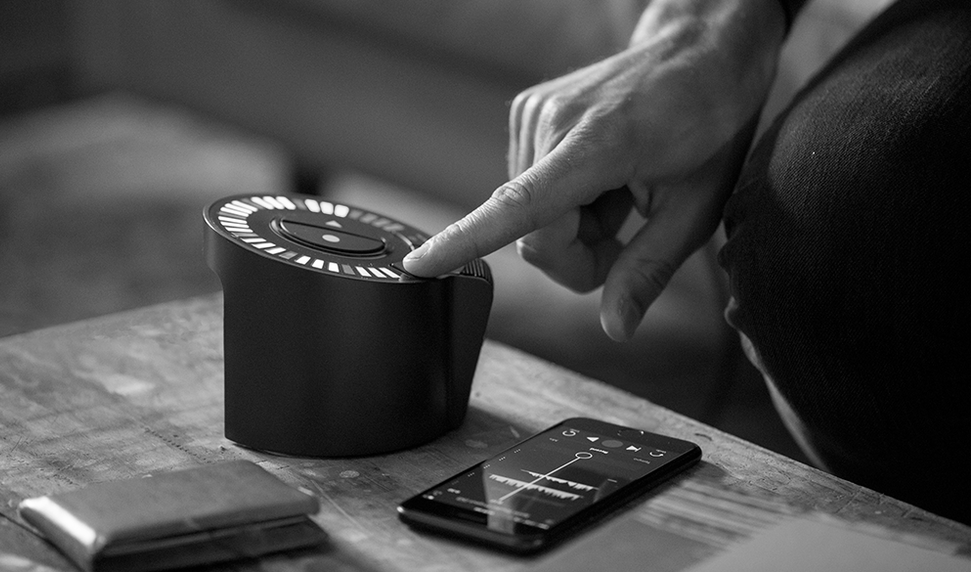iZotope’s new Spire Studio uses Wi-Fi and smart microphone tech to make mobile audio recording even easier.
There are few creativity killers more potent than an overly complex tool. For musicians both casual and pro, such complexity—sophisticated software, plug-ins, cables, audio interfaces, and microphones—can offer a lot of creative control, but just as easily introduce enough friction to wreck a moment of inspiration.
Like so many of life’s annoyances, there’s a tech company trying to fix this one: Spire Studio is a new mobile recording gadget from iZotope, a Massachusetts-based company that has made music recording software and hardware for the last 16 years. Sporting a high-quality built-in microphone, the compact, cylindrical device connects to your iPhone via Wi-Fi to enable simplified, portable multi-track recording into the Spire Studio iOS app. The result is a dead-simple approach to capturing songs and ideas with the help of a gizmo you can throw in your bag.
“When we look at the future of what music recording looks like, it’s going to be wireless,” says iZotope product marketing manager Colin Thurmond. “The world is going wireless and things need to be really simple and accessible and fun.”
For more serious songwriters and musicians, the Spire Studio makes it ultra-easy to record a decent-sounding, multi-layered demo of a song on the go. For beginners, it’s an easy introduction to multi-track recording and the creative possibilities that are unlocked when one can layer different instruments on top of one another.
For both types of musicians, the Spire Studio meets them halfway between a proper laptop recording setup (and all components and cables that requires) and the basic one-track demo recording many musicians do on an iPhone—often through the native Voice Memos app or something like Apple’s Music Memos.
There are multi-track mobile audio apps more sophisticated than Spire Studio’s—the iOS version of GarageBand, for instance—but iZotope’s app seems content to err on the side of simplicity. Rather than trying to cram a full-fledged audio workstation like GarageBand or Pro Tools onto a pocket-size interface, the Spire Studio app offers a stripped-down, visually intuitive interface with a few basic effects and filters that can be applied to each layer of a song. It even eschews a more traditional interface for mixing the levels of the different instruments, opting for a simplified graphical X-Y axis that anyone can understand, regardless of their level of audio-editing experience.
Crucially, the tracks can be exported to other common audio programs like Pro Tools or Logic, where they can be edited and rearranged with all the granularity and sophistication those desktop programs allow. The Spire Studio is more about capturing ideas quickly and easily from any location (provided it’s not too noisy).
If the $350 Spire Studio recording hub has one major advantage, it’s the microphone and onboard audio-processing software. The built-in mic on recent iPhone models is surprisingly high-quality, but the Spire Studio takes things up a notch in a few ways. Not only is the mic itself pro-level quality, but the device’s “sound check” feature allows you to dynamically adjust its sensitivity to match whatever you’re recording. This ensures that vocals come out crisp and clear, but also that a cranked electric guitar amp or a full drum kit don’t sound blown out and distorted.
In addition to its small, forward-facing mic, the device also has two inputs for proper microphones (or other instruments, like guitars or synthesizers) in case one prefers to use fancier microphones or wants a multi-mic setup to record more complicated instruments like drums (which the Spire Studio handles surprisingly well for such a small, unassuming-looking gizmo).
The Spire Studio was also designed to be collaborative. In addition to exporting multi-track files to other audio programs (or mixing it all down to a SoundCloud-ready MP3, if you feel so confident), you can also share the Spire project files with other people and allow them to add their own parts or make edits to your recording. This enables people to collaborate on music regardless of geography and, refreshingly, they’re free to do it using the software and recording tech of their choice.
This is a versatile device that can be used to produce something close to a finished product, but it’s equally useful as a sonic sketchbook that serves as a creative starting point.
Originally posted on FAST COMPANY


